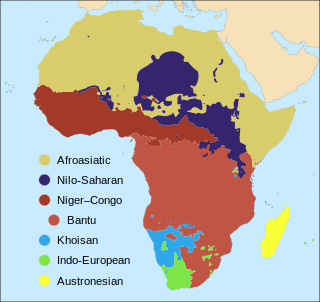Related Research Articles

The Senufo or Senufic languages has around 15 languages spoken by the Senufo in the north of Ivory Coast, the south of Mali and the southwest of Burkina Faso. An isolated language, Nafaanra, is also spoken in the west of Ghana. The Senufo languages constitute their own branch of the Atlantic–Congo sub-family of the Niger–Congo languages. Garber (1987) estimates the total number of Senufos at some 1.5 million; the Ethnologue, based on various population estimates, counts 2.7 million. The Senufo languages are bounded to the west by Mande languages, to the south by Kwa languages, and to the north and east by Central Gur languages.

The languages of Africa are divided into five major language families:
Baka, baká or BAKA may refer to:

Central Sudanic is a family of about sixty languages that have been included in the proposed Nilo-Saharan language family. Central Sudanic languages are spoken in the Central African Republic, Chad, South Sudan, Uganda, Congo (DRC) and Cameroon. They include the pygmy languages Efé and Asoa.
The Sara languages comprise over a dozen Bongo–Bagirmi languages spoken mainly in Chad; a few are also spoken in the north of the Central African Republic. They are members of the Central Sudanic language family. Greenberg (1966) treats all varieties as dialects of a Sara language, whereas Tucker and Bryan (1966) consider the Sara to be a dialect cluster of several languages. Most members of the different Sara languages/dialects consider their speech form distinct languages, but there is currently insufficient language information to determine which speech varieties need to be considered distinct languages, and which are dialects of other languages.

The Banda people are an ethnic group of the Central African Republic. They are also found in the Democratic Republic of the Congo, Cameroon, and South Sudan. They were severely affected by slave raids of the 19th century and slave trading out of Africa. Under French colonial rule, most converted to Christianity but retained elements of their traditional religious systems and values.
Mono is a language spoken by about 65,000 people in the northwestern corner of the Democratic Republic of the Congo. It is one of the Banda languages, a subbranch of the Ubangian branch of the Niger–Congo languages. It has five dialects: Bili, Bubanda, Mpaka, Galaba, and Kaga.
The Gbaya languages, also known as Gbaya–Manza–Ngbaka, are a family of perhaps a dozen languages spoken mainly in the western Central African Republic and across the border in Cameroon, with one language (Ngbaka) in the Democratic Republic of the Congo, with a few small languages in the Republic of the Congo. Many of the languages go by the ethnic name Gbaya, though the largest, with over a million speakers, is called Ngbaka, a name shared with the Ngbaka languages of the Ubangian family.
Avokaya is a Central Sudanic language spoken in southern South Sudan and parts of the Democratic Republic of Congo.
The Zande languages are half a dozen closely related languages of the Central African Republic, the Democratic Republic of the Congo, and South Sudan. The most populous language is Zande proper, with over a million speakers.
Zaghawa is a Saharan language spoken by the Zaghawa people of east-central Chad and northwestern Sudan (Darfur). The people who speak this language call it Beria, from Beri, the endonym of the Zaghawa people, and a, Zaghawa for "mouth". It has been estimated that there are between 750,000 and 1,350,000 Zaghawa speakers, who primarily live in Chad and the Darfur region of Sudan.
The Ubangian languages form a diverse linkage of some seventy languages centered on the Central African Republic. They are the predominant languages of the CAR, spoken by 2–3 million people, and include the national language, Sango. They are also spoken in Cameroon, Chad, the DR Congo, and South Sudan.

The official languages of the Central African Republic are French and Sangho. In total there are about 72 languages in the country.
The Bongo–Bagirmi or Sara–Bongo–Bagirmi languages are the major branch of the Central Sudanic language family with about forty languages. Principal groups include Bagirmi languages such as Naba and the Sara languages. They are spoken across CAR, Chad, South Sudan, and adjacent countries.
The Bongo languages, or Bongo–Baka, comprise six languages spoken in South Sudan. They are members of the Central Sudanic language family.
The Kara languages are Tar Gula and possibly related Central Sudanic languages of the Central African Republic. The name Kara is used for numerous other peoples of the region, and so is often ambiguous.
Bongo (Bungu), also known as Dor, is a Central Sudanic language spoken by the Bongo people in sparsely populated areas of Bahr al Ghazal in South Sudan.
Shemya is the language of the Sinyar people. It is a Central Sudanic language spoken in Chad and formerly in Darfur, Sudan. It is variously spelled Shamya, Shamyan, Shemya, Sinya, and known as Symiarta, Taar Shamyan, Zimirra.
Yulu is a Central Sudanic language spoken by the Yulu people of South Sudan and the Central African Republic (CAR). It has an estimated 7,000–13,000 speakers.
Central Banda is a dialect continuum of the Banda languages spoken by around one million people, primarily in the Central African Republic. The varieties may be mutually intelligible, especially the Mid-Southern–Gobu–Kpagua–Mono–Ngundu cluster. The other varieties are Bambari, Banda-Banda, Mbrès, Ndélé, and Togbo-Vara Banda.
References
- Olson, Kenneth S. (1996) 'On the comparison and classification of Banda dialects'. Chicago Linguistic Society (CLS) 32(1). 267–283.